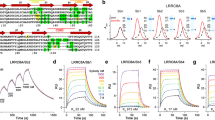Abstract
The family of multidomain proteins known as the synaptic associated proteins (SAPs) act as molecular scaffolds, playing an important role in the signaling and maintenance of several receptors and channels. The SAPs consist of 5 individual protein domains: 3 PDZ (PSD95, Disc Large, Zol) domains, an SH3 domain, and an inactive guanyl kinase (GK) domain. The 3 PDZ domains bind the C-termini of specific receptors and channels, leading to the transient association with cytoskeletal and signaling proteins. Molecules targeting specific domains of the SAPs may provide a novel route for the regulation of channel and receptor function. Here we describe a structural-based approach for the development of such inhibitors for the PDZ domains of SAP90. The high sequence homology of the 3 domains has necessited targeting regions outside the canonical binding pocket. The structural features of the PDZ domains with the C-termini of different receptors (GluR6), channels (Kv1.4), and cytoskeletal proteins (CRIPT) provide insight into targeting these regions.
Similar content being viewed by others
References
Lim IAHD, Hell JW. Selectivity and promiscuity of the first and second PDZ domains of PSD-95 and synapse-associated protein 102.J Biol Chem. 2002;277:21697–21711.
Garner CC, Kindler S. Synaptic proteins and the assembly of synaptic junctions.Trends Cell Biol. 1996;6:429–433.
Garner CC, Nash J, Huganir RL. PDZ domains in synapse assembly and signalling.Trends Cell Biol. 2000;10:274–280.
Craven SE, Bredt DS. PDZ proteins organize synaptic signaling pathways.Cell. 1998;93:495–498.
Hirao K, Hata Y, Ide N, et al. A novel multiple PDZ domain-containing molecule interacting with N-methyl-D-aspartate receptors and neuronal cell adhesion proteins.J Biol Chem. 1998;273:21105–21110.
Garcia EP, Mehta S, Blair LA, et al. SAP90 binds and clusters kainate receptors causing incomplete desensitization.Neuron. 1998;21:727–739.
Kornau HC, Schenker LT, Kennedy MB, Seeburg PH. Domain interaction between NMDA receptor subunits and the postsynaptic density protein PSD-95.Science. 1995;269:1737–1740.
Kim E, Niethammer M, Rothschild A, Jan YN, Sheng M. Clustering of Shaker-type K+ channels by interaction with a family of membrane-associated guanylate kinases.Nature. 1995;378:85–88.
Niethammer M, Valtschanoff JG, Kappor TM, et al. CRIPT, a novel postsynaptic protein that binds to the third PDZ domain of PSD-95/SAP90.Neuron. 1998;20:693–707.
Irie M, Hata Y, Takeuchi M, et al. Binding of neuroligins to PSD-95.Science. 1997;277:1511–1515.
Brenman, JE, Chao DS, Gee SH, et al. Interaction of nitric oxide synthase with the postsynaptic density protein PSD-95 and alphal-syntrophin mediated by PDZ domains.Cell. 1996;84:757–767.
Hillier BJ, Christopherson KS, Prehoda KE, Bredt DS, Lim WA. Unexpected modes of PDZ domain scaffolding revealed by structure of nNOS-syntrophin complex.Science. 1999;284:812–815.
Kim E, DeMarco SJ, Marfatia SM, Chishti AH, Sheng M, Strehler EE. Plasma membrane Ca2+ ATPase isoform 4b binds to membrane-associated guanylate kinase (MAGUK) proteins via their PDZ (PSD-95/Dlg/ZO-1) domains.J Biol Chem. 1998;273:1591–1595.
Deguchi M, Hata Y, Takeuchi M, et al. BEGAIN (brain-enriched guanylate kinase-associated protein), a novel neuronal PSD-95/SAP90-binding protein.J Biol Chem. 1998;273:26269–26272.
Yao I, Hata Y, Hirao K, et al. Synamon, a novel neuronal protein interacting with synapse-associated protein 90/postsynaptic density-95-associated protein.J Biol Chem. 1999;274:27463–27466.
Martin KC, Michael D, Rose JC, et al. MAP kinase translocates into the nucleus of the presynaptic cell and is required for long-term facilitation in Aplysia.Neuron. 1997;18:899–912.
Doyle DA, Lee A, Lewis J, Kim E, Sheng M, MacKinnon R. Crystal structures of a complexed and peptide-free membrane protein-binding domain: molecular basis of peptide recognition by PDZ.Cell. 1996;85:1067–1076.
Tochio H, Hung F, Li M, Bredt DS, Zhang M. Solution structure and backbone dynamics of the second PDZ domain of postsynaptic denistry-95.J Mol Biol. 2000;295:225–237.
Piserchio A, Pellegrini M, Mehta S, et al. The PDZ1 domain of SAP90. Characterization of structure and binding.J Biol Chem. 2002;277:6967–6973.
Mehta S, Wu H, Garner CC, Marshall J. Molecular mechanisms regulating the differential association of kainate receptor subunits with sap90/psd-95 and sap97.J Biol Chem. 2001;276:16092–16099.
Imamura F, Maeda S, Doi T, Fujiyoshi Y. Ligand binding of the second PDZ domain regulates clustering of PSD-95 with the Kv1.4 potassium channel.J Biol Chem. 2002;277:3640–3646. Show: 3645 3610 3620 3650 3100 3200 3500 Sort Author Journal Pub Date Text File.
Grzesiek S, Bax A. Amino acid type determination in the sequential assigment procedure of uniformly 13C/15N-enriched proteins.J Biomol NMR. 1993;3:185–204.
Cornilescu G, Delaglio F, Bax A. Protein backbone angle restraints from searching a database for chemical shift and sequence homology.J Biomol NMR. 1999;13:289–302.
Brunger AT, Adams PD, Clore GM, et al. Crystallography & NMR system: A new software suite for macromolecular structure determination.Acta Crystallogr D Biol Crystallogr. 1998;54:905–921.
Lindahl E, Hess B, van der Spoel D. GROMACS 3.0: A package for molecular simulation and trajectory analysis.J Mol Mod. 2001;7:306–317.
Berendsen HJC, van der Spoel D, van Buuren R. GROMACS: Amessage passing parallel molecular dynamics implementation.Comp Phys Comm. 1995;91:43–56.
Kozlov G, Banville D, Gehring K, Ekiel I. Solution structure of the PDZ2 domain from cytosolic human phosphatase hPTP1E complexed with a peptide reveals contribution of the beta2-beta3 loop to PDZ domain-ligand interactions.J Mol Biol. 2002;320:813–820.
Udugamasooriya G, Saro D, Spaller MR. Bridged peptide macrocycles as ligands for PDZ domain proteins.Org Lett. 2005;7:1203–1206.
Piserchio A, Salinas GD, Li T, Marshall J, Spaller MR, Mierke DF. Targeting specific PDZ domains of PSD-95; structural basis for enhanced affinity and enzymatic stability of a cyclic peptide.Chem Biol. 2004;11:469–473.
Author information
Authors and Affiliations
Corresponding author
Additional information
Published: June 2, 2006
Rights and permissions
About this article
Cite this article
Piserchio, A., Spaller, M. & Mierke, D.F. Targeting the PDZ domains of molecular scaffolds of transmembrane ion channels. AAPS J 8, 45 (2006). https://doi.org/10.1007/BF02854911
Received:
Accepted:
DOI: https://doi.org/10.1007/BF02854911




